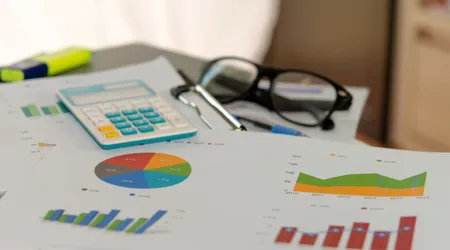Why is a Financial Routine the Foundation of Financial Freedom?
Advertisements
Imagine your financial life like a garden: without regular care, it can grow untidy, with weeds taking over and flowers wilting from lack of attention.
However, with a well-planned routine, you cultivate a thriving environment, where every plant—that is, every financial goal—has room to flourish.
Thus, the financial routine It is not just a practice, but an organizing philosophy that promotes clarity, control, and freedom.
Why, then, do so many people feel that organizing their finances confines them to spreadsheets and apps?
Is it possible to create an efficient financial routine without becoming a hostage to technology?
Find out below!
Financial routine

These days, personal finance apps promise to make budgeting easier, but many end up creating dependency, incessant notifications, or even anxiety.
++ Finances with Low Income: Is It Possible to Live Well and Get Organized?
Therefore, building a financial routine that balances the use of digital tools with manual and conscious practices is essential.
In this sense, this article offers a practical, creative, and intelligent guide to developing a financial routine that is sustainable, adaptable, and, above all, liberating.
We'll explore strategies, practical examples, a relevant statistic, an inspiring analogy, and even a FAQ table to ensure you have all the tools you need.
Furthermore, throughout the text, we will use approaches that avoid clichés and repetitions, with natural transitions that reinforce the relevance of the financial routine for different profiles, from freelancers to CLT professionals, from students to entrepreneurs.
++ The difference between being frugal and being stingy with finances
This will help you learn how to manage your money strategically without feeling like you're tied to an app.
Step 1: Setting Clear Goals for Your Financial Routine

First of all, create a financial routine starts with clarity of purpose.
Without defined goals, any attempt at financial organization can seem like a boat adrift, with no clear destination.
So the first step is to ask yourself: what do I want to achieve with my money?
Whether it's paying off debt, saving for a trip, or investing for retirement, each goal requires a specific approach.
For example, a young professional may want to save 20% of their monthly income for an emergency fund, while an entrepreneur may prioritize reinvesting profits into their business.
To illustrate, consider the case of Ana, a 28-year-old freelance designer.
++ Finances for Millennials and Generation Z: How to Get Organized Without Relying on Your Parents
Ana realized that her variable income made it difficult to control her finances, so she decided to create a routine based on goals.
She set three goals: set aside 15% from each project for taxes, save 10% for a trip, and invest 5% in a fixed income fund.
With that, Ana divided her finances into “baskets,” an analogy we’ll see later, and began tracking her expenses weekly, using just a notebook and a simple spreadsheet, without relying on app notifications.
Furthermore, according to a survey by the National Confederation of Shopkeepers (CNDL) in 2023, 65% of Brazilians do not have a financial reserve, often due to a lack of one financial routine structured.
Therefore, defining clear objectives is not just a matter of organization, but a strategy to escape statistics and build security.
Instead of relying on apps that automatically categorize spending, try starting with a manual method like the “50-30-20 budget” (50% for needs, 30% for wants, 20% for savings), tailoring it to your specific goals.
Step 2: The Basket Analogy: Organizing Your Finances Like a Market
Think about your financial routine like a farmers' market, where each basket represents a category of spending or investment.
Just as you separate fruits, vegetables, and grains to keep things organized, your finances need clear buckets: fixed expenses, variable expenses, savings, investments, and even a “contingency bucket.”
This analogy helps you visualize your routine in a simple and practical way, without the need for complex applications that often overload you with unnecessary data.
For example, John, a 35-year-old teacher, adopted the basket method to organize his finances.
He created four categories: “Essential Expenses” (rent, bills, groceries), “Leisure” (going out, hobbies), “Future” (savings and investments), and “Unforeseen Expenses” (car maintenance, medical emergencies).
João reviews his baskets every Sunday night, writing down the week's expenses in a notebook and transferring the amounts to the corresponding baskets.
This practice, which takes just 20 minutes a week, has replaced the need for an app, as João now understands his money flow intuitively.
Furthermore, the basket analogy allows for flexibility. Unlike apps that impose rigid categories, you can customize your baskets to suit your needs.
For example, if you are self-employed, you might include a bucket for “taxes” or “professional reinvention.”
Thus, the financial routine becomes a reflection of your life, not a generic formula imposed by an algorithm.
The key is to keep it simple: fewer notifications, more intuition.
Step 3: Hybrid Tools — Combining Digital with Manual
While the goal is to avoid app dependency, this doesn't mean abandoning technology completely.
On the contrary, a financial routine can effectively combine digital tools with manual practices to create a balanced system.
For example, you might use an app to quickly track your expenses throughout the day, but set aside time each week to analyze that data in a spreadsheet or notebook, reflecting on patterns and adjusting priorities.
In this context, choosing the right tools is crucial.
Apps like YNAB or Mobills can be useful, but they should be configured to suit your routine, not the other way around.
For example, turn off automatic notifications and limit usage to a 5-minute check daily.
Additionally, complement this with manual methods, such as the "digital envelope": instead of physical envelopes with money, create separate accounts or categories in your digital bank for each financial "basket."
This also reduces the temptation to spend more than planned and maintains control without requiring an app for every decision.
Furthermore, periodic reviews are essential. Once a month, set aside an hour to evaluate your financial routine.
Ask yourself: Are my baskets balanced?
Am I spending more on leisure than I should?
This strategic thinking prevents you from becoming a “slave” to automatic notifications or reports.
By integrating digital with manual, you gain autonomy, using technology as an ally, but without allowing it to dictate your choices.
Step 4: Automating Without Losing Control
Automating processes is a smart way to maintain a financial routine without constant effort.
However, automation must be strategic, avoiding the trap of delegating everything to applications or banks.
For example, set up automatic transfers to your savings or investments on your paycheck.
This ensures you prioritize your goals before spending on variable expenses, but without having to check an app daily.
Furthermore, automation does not eliminate the need for follow-up.
A common mistake is setting up automatic debits and forgetting to review them, which can lead to unnecessary expenses, such as forgotten subscriptions.
So, make it a habit to review your automations quarterly.
A practical example is that of Mariana, who automated 10% of her salary to an investment fund and 5% to an emergency account.
However, she maintains a monthly ritual of checking whether these transfers are aligned with her goals, adjusting the amounts as needed.
Ultimately, automation should be a complement, not the core of your financial routine.
Use it to simplify, but preserve moments of active reflection.
After all, money is a reflection of your choices, and delegating everything to an algorithm can disconnect you from your own values.
How would you ensure that your financial routine reflects who you are, and not just what an app suggests?
Step 5: Adapting Your Financial Routine to Your Reality
Not all financial routine works for everyone.
A student with limited income requires a different approach than an established professional. Therefore, personalizing your routine is essential to making it sustainable.
For example, if you have a variable income, as freelancers do, try the "pay yourself first" method: set aside a fixed percentage for savings and taxes before allocating the rest to expenses.
Furthermore, flexibility is key to avoiding frustration.
If a month is tighter, adjust your baskets guilt-free, but stay committed to your long-term goals.
For example, if Ana, a freelance designer, faces a month with few projects, she temporarily reduces her “leisure” basket to prioritize the “future.”
This adaptability ensures that the routine is a guide, not a prison.
Finally, celebrate small victories.
Reaching a milestone, like paying off a debt or completing three months of savings, reinforces the habit.
In short, use these achievements to adjust your routine, making it more aligned with your dreams.
After all, a financial routine It's not about rigidity, but about creating a system that evolves with you.
Frequently Asked Questions About Financial Routine
| Question | Response |
|---|---|
| Do I need an app to organize my finances? | No, you can create an effective routine with manual methods, such as notebooks or simple spreadsheets. Apps are optional and should be used as complementary tools. |
| How much time should I dedicate to my financial routine? | About 20 minutes a week to review expenses and 1 hour a month for more in-depth analysis is enough for most people. |
| How to avoid app dependency? | Disable notifications, limit usage to quick checks, and prioritize manual reviews to maintain conscious control. |
| What if my income is variable? | Use the “pay yourself first” method, setting aside fixed percentages for savings and taxes before allocating the rest. |
| Can I automate everything? | Only automate transfers to savings or investments, but review regularly to ensure they reflect your goals. |
Conclusion: A Financial Routine that Liberates
Create a financial routine It's more than just organizing numbers; it's an exercise in self-knowledge and freedom.
By setting clear goals, using the basket analogy, combining digital and manual tools, strategically automating, and adapting your routine to your reality, you build a system that works for you, without relying solely on apps.
With examples like Ana and João, we saw that it is possible to manage finances in a practical and intuitive way, while the CNDL statistics reinforce the urgency of adopting a structured routine.
So start today.
Grab a notebook, define your baskets, adjust your automations, and set aside time to reflect.
Your financial routine It doesn't have to be perfect, but it should be yours.
After all, how do you want your money to tell the story of your life?
